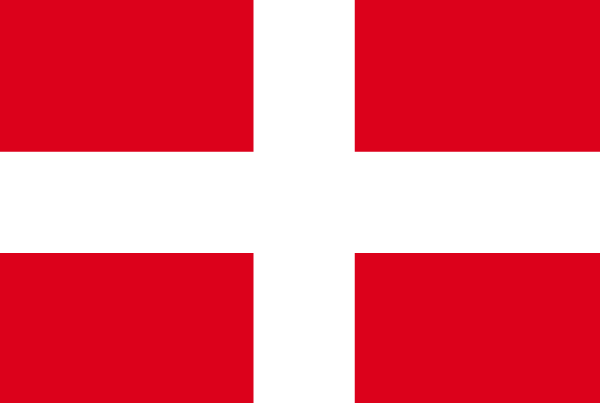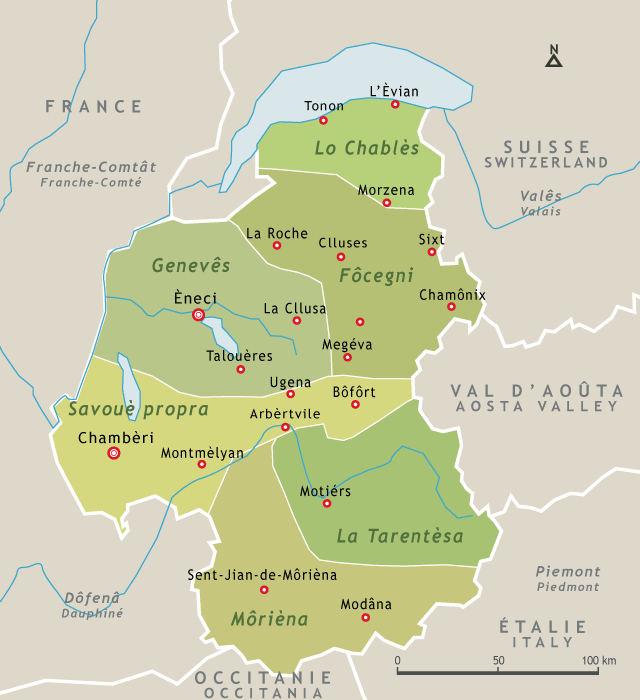Savoy and Aosta, heart of the Arpitan people

Arpitania designates the area where Arpitan is the traditional minority language. Inhabited since the Paleolithic era, the country lies on the borders of three European states – France, Italy and Switzerland.

Various Celtic tribes settled on Arpitan land, the most famous being the Allobroges. They found themselves rapidly integrated into the kingdom of Burgundy, comprising Burgundy and Sapaudie (Savoy). It is at the heart of the kingdom that the Arpitan language developed from Latin.
The concept of Arpitania dates from the 1970s. A Valdotain party, the Arpitan Movement uses the old term “Arpitan”, formed from the root of the pre Indo-European “alp”, in its modern variant dialect “arp”, which referred to the mountain pastures. The confusion generated by the term “Franco-Provençal” invented in 1873 was then cleared up and it defined the language according to its phonetic characteristics.
The term “Arpitan” therefore specifies the language according to the social characteristics of the people who speak it: it is the language of the Arpians, the shepherds. Arpitan consciousness developed in the 20th century, when groups of speakers of the vernacular language took the initiative to organise international meetings on a regular basis in one or the other regions of Arpitania. Although aware of speaking the same language, though rich in local characteristics, residents continue to claim to represent their historic region, Savoy and the Aosta Valley being the two most symbolic regions of this vast territory.

Identity card

| Name | Arpitania | Franco-Provençal Arpitanie | French Arpitanien | German |
| Population | 7,000,000 inhab. |
| Area | 60,000 km² |
| Languages | Arpitan | Franco-Provençal Français | French Italiano | Italian Deutsch | German, Walser German |
| Number of native speakers | 140,000 | Franco-Provençal (1998) |
| State of guardianship | France, Italy, Switzerland |
| Official status | No particular status (departments in France, cantons in Switzerland, autonomous region in the Aosta Valley in Italy |
| Capital | Chamèri | Franco-Provençal (Chambéry) Aosta | Franco-Provençal |
| Historic religion | Roman Catholic and Protestant |
| Flag | Lo rozon | Franco-Provençal (The rosette) |
| Anthem | Les Allobroges | French (Savoy) Montagnes valdôtaines | French(Aosta) |
| Motto | Fier et a l’abada tanqu’a la fin | Franco-Provençal (proud and free until death) |

Timeline

- 443 • Foundation of the kingdom of the Burgunds in Sapaudia.
- 888 • Second Kingdom of Burgogne: cradle of the Arpitan language, stretching around the area of Lyon-Geneva.
- 1860 • Savoy is annexed by France after a Napoleonian “plebiscity” (99.8%)
- 1943–5 • The Aosta Valley is liberated by the armed struggle of the fascist yoke.
- 1948 • The Aosta Valley becomes an autonomous region.
- 1973 • Birth of Arpitan conscience: a Valdotain movement proposes a new spelling for the language and demands the union and the freedom of Arpitainia.
- 2000 • After the breakthrough of the 1998 elections where there was a leaning towards independence, a CSA poll reported that 23% of the inhabitants of Savoy would support independence.
- 1998–2003 • The linguist Dominique Stich provides a standard orthography to Arpitan, the ORB, providing a tool for mutual comprehension in writing between the many variants.

Brief history

One of the highlights of the history of Arpitania remains the annexation of Savoy by France. This term is preferred to that of “incorporation” used in school textbooks. Despite the long or short periods of occupation, Savoy was often independent or at the forefront of bigger territories. It was not until 1860 that Savoy became French after the Treaty of Turin and a referendum now considered flawed (99.76% of the 130,839 voters voted for incorporation). The Treaty of Turin was in fact a deal between France and the kingdom of Piedmont-Sardinia, who wished to unify Italy to retain the favour of their French neighbours. The most ironic thing being that this kingdom was ruled by the house of Savoy. This treaty is considered to be null and void by many Savoyards as its demands were not adhered to.

Geography

Arpitania is the territory of people of the Franco-Provençal language, also called Arpitan. In the west are the mountains and plains of Forez, the Pilat, the mountains of Vivrais, Beaujolais and Lyonnais. In the middle, the territory is crossed from north to south by the Rhône Valley, which marks the historic border between France and Savoy. From both sides, there are large areas in low relief (Bresse, Dauphiné, Dombes) and hilly areas (Bugey). The region is mountainous in the east also (Jura and the Alps). Further east still, in the Aosta Valley and in Valais we find Mont Blanc – bordering Savoy – Mont Rosa, the Matterhorn, Gran Paradiso and Rutor Head. All of Arpitania is distinguished by the presence of Arpitan. Lyon is the principal city of this vast Alpine and pre-Alpine space. Other cities like Grenoble, Geneva, Lausanne or Saint Étienne mark the territory made up of many countries (18 shown on the map above) and divided between three states (France, Switzerland and Italy).



Focus on Savoy


Belatedly incorporated into France by the Treaty of Turin in 1860, Savoy has maintained and still actively maintains a strong attachment to its former glories. The dynasties of Savoyard sovereigns date from the 11th century. Dukes since the 15th century, they extended their lands to Sicily and Sardinia in 1720 to create the states of Savoy, a power recognised at European level. Its original name in Latin, Sapaudia, which means ‘fir tree’ in French, makes reference to the many conifers inhabiting the slopes of high mountains. A real buffer territory between the Frank, Italic and Germanic worlds, Savoy made up part of Lorraine before becoming a sovereign state in the 16th century. In 1919, the French state put an end to the neutrality of Savoy, contrary to the terms of the Treaty of Turin. It was condemned by the international tribunal in 1932 without having any real effect. This turbulent history explains the success of the Savoisian separatist and regional movements (terms they prefer to Savoyard, which is pejorative). The Savoy Region Movement founded in 1971 has been campaigning since then for more autonomy. Since the start of the 1990s, competing political parties (including the now famous Savoy League) have had many electoral successes. In fact, in a recent poll, 23% of Savoyards were in favour of independence. Made up of six provinces (Ducal Savoy, Chablais, Faucigny, Tarentaise, Maurienne, Genevois), Savoy is part of the whole of Arpitania. The native speakers of Arpitan and Franco-Provençal are numerous.



Focus on Aosta


Part of the whole of Arpitania as well as Savoy, the Aosta Valley is a specific area because of several unique features. First, it is included in the Italian state, where it has had special autonomous status since 1948. Arpitan (Franco-Provençal) is practised by a large part of the population. With an area of 3,263 km², the Aosta Valley borders the canton of Valais to the north, Savoy to the west, separated by Mont Blanc and Piedmont to the south and the east. A region of mountains, the Aosta Valley is named after Augusta Praetoria, the capital having been created in honour of Augusta. The Burgundians reigned for over five centuries from the 5th century, followed by the Lombards and the Franks. Incorporated into Savoy from the 11th century, the Aosta Valley has always retained a large degree of autonomy as a duchy, even after it became part of Italy in 1861. Under the fascist yoke, a policy of assimilation had grave consequences on linguistic practice: French was no longer taught from 1925 and place names were replaced with Italian names in 1939. After the end of the war, Federico Chabod, the Valdotain president, obtained a special status for the Aosta Valley. Populated by little more than 120,000 people, the Aosta Valley, whose official languages are Italian and French, is nowadays a prosperous region maintaining greater ties with its Arpitan neighbours.

Language

Arpitan
Arpitan (also called Franco-Provençal, not to be confused with Provençal) is spoken in the pre-Alps and in Savoy, to the south of Romandy and in the Aosta Valley. It is one of the principal Gallo-Romance languages. Discovered only in the 19th century, there has been no consensus on its particularities and borders. Its rich literature started from the end of the 13th century and has continued without interruption up to the 21st century. The Valley of Lys, between Aosta and Piedmont, is populated with descendants of a German-speaking population – the Walser. It does not benefit from widespread promotion, unlike other minority languages. Unfortunately its future seems very uncertain.

